
ELAGE DIOUF
MELOKAANE (Pump Up the World)
This album has been in my inbox for a while. I almost rejected it for trying too hard, as it is all over the map, musically speaking, but came back to it, and, after deselecting one track and ignoring some aspects of others, I am beginning to think it's pretty impressive. First though is the artist's name, Elage, which I think is a different way of spelling "El Hadj," meaning a Muslim pilgrim. Is this a sleight of tongue to disguise his spiritual affiliation, or am I over-interpreting? The title Melokáane means "reflection of a life's journey" in Wolof, so that explains why there were so many styles on here. Just as if you asked me to play a set that typified who I was, you'd get Bach, Monk, the Who, Carleton & the Shoes, Gershwin and Harry Warren, as well as the music you see me writing about on here. So it's fair to say that if he is presenting a self-portrait he is not going to present a unified concept album (Aside, do you know what the first concept album was? Give up? In the Wee Small Hours by Frank Sinatra, Capitol, 1955). So, the informing concept behind this album is a Wolof proverb: "You are everything you are not, until you finally become who you truly are." That's a fine idea and explains why he is aspiring to the Peter Gabriel and Youssou Ndour level on one hand and the rootical African who turns his back on the allurements of Western arena rock on the other. He is trying it on. Both those artists I mentioned are present in spirit: he covers Gabriel's "Secret World" in Wolof, and not only sings like Youssou when he tries, but has Youssou's great guitarist "Jimmy" Mamadou Mbaye on "Sankara," a song about the fallen African leader. There is an mbalax feel to the percussion, which gets rolling on the title cut. I had to delete the next track "Just one day" featuring Johnny Reid who is paradoxically described as a "Canadian superstar" -- yes, I have heard of Justin Bieber and Celine Dion, but really! (I googled "Canadian superstar Johnny Reid" and found he recently held an exclusive bottle signing event at the Liquor Mart in Winnipeg.) OK, better off without. I have no idea who Jordan Officer is, but he adds a Howlin Wolf skirl to the guitar on "Tay" which is the best track on here. We press on, past the Gabriel cover, and come to a reggae track "Probleme yi" which is gratuitous, followed by an effort to do something more uptempo with Black Ark dub effects, but featuring over-miked drums and an inept keyboard which starts to go into a montuno when they cut the tape. Speedy mbalax helps him climb out of the hole he has dug with the dance track "Sai sai." He goes out in grand style (the "full Gabriel" with synths and choirs on echo) on "Dekoulo Fi" about an immigrant being deported, despite his best efforts, his dream is shattered. If this album was an EP of only the first four tracks, it would be a gem.
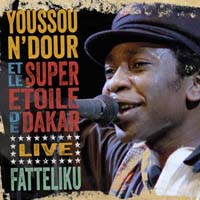
YOUSSOU NDOUR ET LE SUPER ETOILE DE DAKAR
FATTELIKU: LIVE IN ATHENS 1987 (RealWorld)
This new release reminds us of the excitement we felt when Youssou first toured the West. He was an energetic young performer and had caught the attention of Peter Gabriel of WOMAD and RealWorld Records, and Gabriel invited his band to open for him on a world tour. This brought him to San Francisco in 1987 and I got to meet him and translate for my friend, Papa Freddy, who interviewed him on his radio show. It was the first in a series of wonderful shows that Ndour put on in Northern California and, as this disc attests, around the world. It was recorded in Athens and has fantastic sound. Actually the set-up was to film a live show of Peter Gabriel and this disc is a by-product. Youssou's set is a mix of classic mbalax and the English pop he was trying to work into the act to appeal to non-Senegalese audiences who had come out to hear PG. This of course became a dilemma as it led to the forgettable "Seven Seconds" with Neneh Cherry (I think it's crap but it has had 10 million viewers on YouTube, compared to 3,000 for one of his classic live performances). Here he is joined by Gabriel for the latter's "In Your eyes," but it's his classics "Ndobine," "Kocc Barma" and "Immigrés" that stand out. There is intense energy here, partly due to the frantic talking drums (sabar, tama and djembe in dialogue) of Assane Thiam, Falilou Niang and Babacar Mbaye, abetted by Habib Faye's popping bass and the smooth sax of Thierno Koite (who has also backed Cheikh Lo and appeared with Baobab and Le Sahel). I am sure the musicians learned from their counterparts on tour: Gabriel had the great Tony Levin on bass, David Rhodes on guitar and David Sancious on keyboard, and they step up to perform the hit "In Your Eyes." However this is a Gabriel song and very different from Etoile de Dakar, despite having Youssou wailing in the background. I think they could have left it off, but you can always skip it if you just want the mbalax.
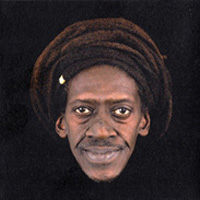
CHEIKH LO
BALBALOU (Chapter Two/Wagram 3322982)
I am trying to figure something out about aging and art. I suppose it should be self-evident that artists who are firey in their youth get mellower with age. We saw it with Baaba Maal and now the great Cheikh Lô (who has just turned 60) has created an album which has flashes of his old intensity, and is produced to the highest level, but is largely easy listening. On the other hand, with age comes wisdom so a stronger distillation of an artist's early essence may become more evident. This new album from Cheikh Lô, his fifth, was recorded in Stockholm. He set the bar high with his 1999 album Bambay Gueej on the World Circuit label. That disc crackled with energy and had an all-star line-up on it, grooving from salsa mbalax to funk and soul. There were Thierno Kouyate (Baobab, Ouza) on sax and Pee Wee Ellis (James Brown, Van Morrison) on horns and arrangements, Richard Egües (Orquesta Aragón) played flute, Oumar Sow (from Super Diamono, Ouza, and Youssou's band) played guitar and other Senegalese & Malian luminaries were present. Lô puts out an album every five years, so it's safe to say he is not a trend follower, he just moves along at his own pace making great songs. He usually includes a telling cover song, such as Bembeya's "Doni Doni" on Jamm. His big influence as a young man was Cuban music but he hangs out with Youssou Ndour and Oumou Sangare, so traditional West African music is more evident in his current work. In actuality however there are only light touches of kora and sabar: it's mostly keyboards and horns with a lot of guitar. Lô is Burkinabe, born to Malian parents, but gravitated to the music scene in Senegal where he became a member of the Baye Fall brotherhood, a Sufi sect who are partly responsible for Senegal remaining a calm place. The album starts with his strongest card: a song about Amadou Bamba, founder of the Mouride Brotherhood. The mellow quotient is signaled by a track with accordion and Flavia Coelho singing, and the predominance of ballads. "Leer Gui Fall" is another religious praise song, with a big horn section and pedal steel guitar. Even a song about revolution is laid back. He often resorts to falsetto so his voice floats off between the synthesized strings and acoustic guitars. Things spark up in the middle with a cover of Sam Mangwana's "Suzanah Coulibaly," sung in French. It's a sad song about a faithless woman but shows the pan-African reach of Mangwana's influence. Then "Balbalou" features Ibrahim Malouf on trumpet. It's a sonically engaging fable in a fine arrangement. And we drift off gently into the night.
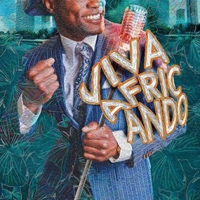
AFRICANDO
VIVA AFRICANDO (Sterns STCD1120)
What? -- the eighth Africando studio album, you gasp! What new ideas can they bring to this? I felt they fell off after their first couple of albums (21 years ago already), which were blockbusters, but actually they are right in the groove here. It's mostly the same sound you will know: polished ballroom salsa session guys from New York backing some soulful African singers. They're missing the late Gnonnas Pedro, and refer to him throughout, but the singers are in full throat and the glitterball is glinting. There's Amadou Ballaké, Medioune Diallo, Sekouba Bambino (the vocal star of Bembeya Jazz National), and Roger Shoubou (of Haiti's great Tabou Combo), from the core group on vocals, with added guest shots from James Gadiaga, Jos Spinto, Lokombe, Rene Cabral (from Cabo Verde), and Ray de la Paz with the Spanish Harlem Orchestra all taking turns on the mike! As usual, Boncana Maiga does most of the arranging. And once again the approach to the playlist is familiar: some of the singers' individual hits remade in a new and improved smooth style. They open with a quote from "Doni doni" by Bembeya Jazz, and you would think me remiss if I did not mention that this is an oblique "Peanut Vendor." Jimmy Gadiaga's "Xamsa bopp," a classic from Super Cayor de Dakar, is given the full treatment, even a strident tres solo! Pascal Dieng was also in Super Cayor (this is his second album with Africando) and another Senegalese singer, Bassirou Sarr (ex-Dieuf Dieul) also returns. Oscar Hernandez on piano is solid as is, of course, the swinging electric bass, the cornerstone of any tight salsa dura session. This was recorded in Paris: a good meeting ground for the two musical styles that diverged over the Atlantic and are now reunited. Actually the key player, arranger Boncana Maiga was in Mali when the civil war erupted and couldn't get a US visa but was able to travel to France. The recording is crystal clear, the pots are hot and you can hear every chomp of the guiro, every trill on the bongo, every timbales trinkle, every brassy bomp. "Es para ti Gnonnas" takes the late vocalist's "Von no no no" riff and spins it out as a montuno, with fellow Beninois Jos Spinto taking the lead. And in fine Africando tradition we have singers dying on us. This time it's Raymond Fernandez who recorded "Destino" for the last album Mandali before pegging out, so it has been added in here to remind us of our mortality. Now, it's not all Senegalese salsa: as you know many African countries created their own versions of the Latin beat, and we get a lovely rendering of Ntesa Dalienst's classic rumba congolaise "Maria M'Boka" sung by Lokombe Nkalulu (who was with Dalienst in Les Grands Maquisards. For some reason the classic Maquisards tracks have never resurfaced on CD: you can find "Maria Mboka" on Sonodisc's Merveilles du Passé 1968 1969 [360 155]). Dieng's "Yen Djiguengny" is another son montuno, and seems to be based on "Como esta Miguel" by Sexteto Habanero, but how come I don't have any Super Cayor albums?! They must have recorded at least one. However, the real surprise is still ahead and it arrives suddenly and so inevitably you wonder how it didn't happen before. I am talking about a medley titled "Noche con Santana," that features the hits of our very own Santana: "Samba pa ti," & "Oye Como Va" that segue into "Black Magic Woman." (Yes I know "Oye como va" was written by Tito Puente and Peter Green wrote "Black Magic Woman," they are still identified with Santana who had the bigger hits with them.) Things change up again when electric guitar enters, not for the Santana cut, but for the last Africando track "Bouré Yayé Diama," which then segues into the more familiar guiro, bongo and horn attack. Then we get a guest shot, the redoubtable Spanish Harlem Orchestra perform "Africa Es," which is their tribute to and medley of Africando. Africando deliver abundant surprises and enough interest to warrant your attention once again.
TERANGA SENEGAL (Stern's STCD 1118-9)
I am increasingly ambivalent about compilation albums. They are a good way to sample music but not always well-sequenced enough to enjoy in themselves. Increasingly we turn to the internet to learn about music: we can listen to radio shows on-line, google or youtube bands for samples, and even hear whole albums on soundcloud & other sites before buying them. You can discover an artist through a great track and buy the album only to find that the great track is the sole reason to have the album, so from that perspective comps can be useful in saving space and money. On the other hand comps invariably have tracks you have to skip which means you cannot just put the disc on and let it roll. In 2009 Syllart issued a double-disc in their African Pearls series called The Teranga Spirit. I skipped that because it was a recompilation of classic Senegalese tracks from Baobab, Star Band, Star Number One, Ifang Bondi, Guelewar, etc, that I surely have. Now Stern's has issued a double-disc of more modern material, also compiled by Sylla (with two songs from nearly every artist). While personally I prefer the sound of the previous generation, this more modern set has its moments. There are a couple of old-timers: 75-year-old Ablaye Ndiaye Thiossane, who had hits in the 60s and then vanished until his debut album appeared in 2011 (he keeps the old Afro-Cuban sound warm and is represented here by three cuts); Idrissa Diop, who toured with Xalam "back in the day" and moved to France, but has now returned to Senegal; and Ndiaye Samba Mboup whose career also stretches back to the 1960s (& shows the enduring influence of Youssou). The other artists are the younger generation: the feel is acoustic and light, almost folky with occasional outbursts of mbalax drumming. There are forgettable tracks and of course loungey moments (which Mark Hudson calls "poolside mbalax"!) as well as hip hop and some other unnecessary contributions. Outstanding among the newcomers are Les Frères Guissé and Ablaye Mbaye who sounds a lot like Youssou with less driven backing. Daby Baldé (whose debut disc and live sequel got rave reviews from me) is included. Simone Sène's raw track, "Léopold Senghor," stands out because instead of guitar and hand drums it has a fiddle accompaniment and is delivered as an anguished complaint. The second disc opens with Yoro Ndiaye in a mode best described as Youssou Lite. I start to get trigger-happy as the synthi backing becomes prominent on disc two, and skip forward increasingly, certain a single disc would have been sufficient. The deal breaker is the muzak version of "Pape Ndiaye" of Baobab performed by Jules Guèye, which leaves a sour taste.
ABDOU DIOP
NOOTEE (Stern's STCD1114)
Abdou Diop is from the Casamance region of Southern Senegal. Against his parents' wishes he enlisted in the Army and, in the capital Dakar, ran into Baaba Maal who encouraged him to stick to his Pulaar roots, rather than adopt the Wolof sound of the North. He plays acoustic guitar and has assembled a wide array of talented sidemen for his second album. There's bass and lead guitar and calabash. In addition there's hoddu and flute plus more percussion on some tracks. Three different guitarists guest at different times to increase the variety (they also bring their tunes): the constant is Diop's fine voice and guitar. His lyrics celebrate simple pastoral themes: A man wants to pick fruit but the tree is across a river; to venerate cows they are given salty water with tree leaves and bark as a treat to encourage milk production. The name Casamance always brings to mind that dreamy Touré Kunda album from the 1980s "Casamance au clair de lune (Casamance in moonlight)," which was the best, rootsiest thing that group did before they shot to overnight fame with the Lambada (sic). Diop has a similar dreamy vocal style and when he adds Massamba Diop on tama and Ibrahim Cissokho on guitar things really take off. Baye Mahanta Diop's guitar on "Weliyaade" is also haunting and sets up a mysterious atmosphere over the insect-like percussion and thwack of the hoddu.
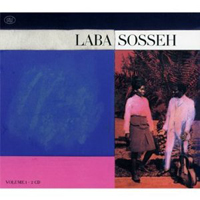
LABA SOSSEH
BELLY POCK* VOLUME ONE (Syllart 000989)
I have been urged by the gentle folk at Stern's to stop referring to Ibrahim Sylla as "the old pirate," since apparently he may have legal title to the many works he issues. He made a deal with the Guinean government to lease the Syliphone catalogue (since his name is Sylla it is easy to assume he had some involvement with that august label, but he did not). Anyway, according to one source, the president of Mali, Amadou Touré, was so thrilled to hear the songs of his youth again he told Sylla he could have the rights to the catalogue of historic Malian music (quite a slice of musical history) to bring it back. As you know the president was deposed in a coup and who knows if he even had the authority to transfer such rights and whether such a promise is legal. I suppose the sentiment is that it's better to have one African ripping off his brothers than for them to be getting the shaft from white Europeans. I am fortunate because I have been collecting African music long enough to have found a lot of the stuff Sylla reissues back when the artists were getting a cut, or at least it was clear who owned the music that was being marketed. So I didn't need to invest in the African Pearls series or the Gnonnas Pedro or other Salsa Africana discs he has put out (or fall for his deceptive labeling tricks).
Laba Sosseh is from Sénégambia though he made his name as a singer throughout West Africa. This two-disc set is of wildly varied quality, including tracks recorded with Dexter Johnson and some from his Lassissi sessions recorded in the USA. Sad to say though the sound is appallingly bad. The first disc is largely unlistenable: you cannot hear Laba's warm voice, let alone appreciate it. "Seyni," "Aminata," and "El Manicero" come from a Disques MAG album, El Sonero de Africa, vol 1, which I think was recorded at the Djandeer Nightclub in Dakar, though I have an equally thrashed 45 of "Guantanamera" and "El Manicero" from the Sangomar nightclub in Thies. It may be impossible to restore the sound of these but we are fortunate that Sosseh recorded his hits numerous times, so if you don't have any of his recordings, there are many later recordings and reissues on the market (The 1991 self-titled disc on SAR is particularly fine, plus any of the Salsa Africana series on Sacodis). My rare 45 (included here) has fetish value only, it is not something you want to play! Stefan Werdekker, the sage behind WorldService, the most respected African music blog on the net, avers that he prefers the roughness of the early work to the slicker New York sides. I mention that in passing, in case you prefer to explore these things for yourself, and not take my word for it.
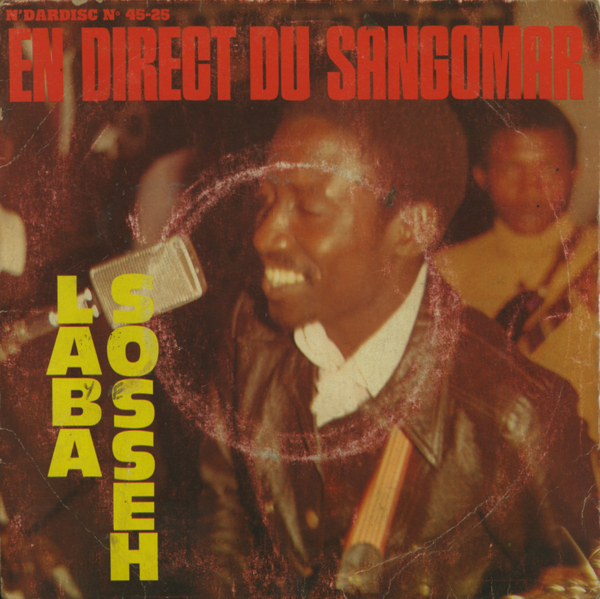
After fronting Dexter Johnson's Super Star band in Dakar in the mid-1960s (the best of those sessions are found on Dakar Sound's Serie Sangomar), Sosseh joined the rival L'Etoile de Dakar and his early hits "Aminata" and "Seyni" were covered by Rochereau, Bembeya Jazz and others. A dozen of his Star Band sides were collected by Cantos in 2009 as Classic Titles. He then went to Mali and sang with the Rail Band (before Mory Kanté and Salif Keita's time) for a while before moving further east to Ivory Coast. It was in Abidjan that he made his biggest impression and began recording for Abdou Lassissi. His album Formidable Laba Sosseh (Sacodis LS5-77, 1977), backed by the Liwanza Band (which I am certain is not related to the Congolese Special Liwanza) is included here in great part. This is a good service, as this album is not often found in good condition, but this version sounds only slightly better than bootlegs in circulation from blogs. We get "No quiero el son," "Prepare Candela," "La Portugita," "Aye que no," and another overmodulated take of "El Manciero" from there -- most of the album. Laba Sosseh even went to New York and recorded with Orquesta Broadway and the Cuban sonero Monguito. We begin to get a sense of his exciting performance in the longer cuts like "Abidjan me voy," towards the end of disc one, and the other tracks from Salsa Africana vol 4, which you can download for 89 cents a track on amazon, though I doubt their sound is any better. The main difference between Laba Sosseh and other African salseros is that he was so good he got to play with real salseros (put together by Roberto Torres in New York) instead of Africans who had only heard salsa records and were imitating it on guitars. Much as I love the ersatz Cubanismo of Africa, it does make a difference, so here's Alfredito Valdez on piano and Pupi Legaretta on violin. The logic behind Sylla's approach seems to be quantity is better than quality (this is a ridiculously overpriced import), but the artist would be better served by a single disc combining the one or two listenable tracks from disc one with the bulk of disc two, then omitting the tracks that are presented in differing versions and the last five cuts which are all available on two of his previous CDs (that I reviewed on the Salsa page, after his death in 2007). To compound his folly, Sylla has accidentally included Monguito as vocalists on two cuts from the classic Monguito presents Laba Sosseh in USA album.
*Sylla also gives himself credit for "tracklisting" so you know there's going to be some major typographical errors!
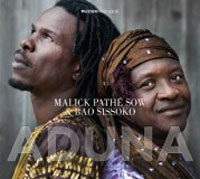
MALICK PATHE SOW & BAO SISSOKO
ADUNA (Muziekpublique05)
Senegal has its electric bands centered in the capital, but the interior stretches out to Guinea, Ivory Coast, Mali and surrounding countries, and the people, like the Mandinka and Fulani, have heritages that come from the far-corners of old empires. The Mandinka, who are about 11 million in number, are mainly based in Mali, while the Fula are found all across Saharan North Africa. Malick Sow (a Fulani) and Bao Sissoko (a Mandinka griot) are based in Belgium. On this disc we have Sow who plays guitar and hoddu (a small ngoni-like instrument), and Sissoko on kora. Both men sing, and they bring in a calabash player and a couple of others to regale us with modern versions of their tales derived from their long oral tradition. The mood is gentle, wistful at times, and highly conducive to revery. The kora is often set to nursery mode but it's not all lullabies: the hoddu serves up some tight grooves, as on "Ndaw Weinde (It's a beautiful day)," a popular Arabic love song and subsides again on the title cut which shows off the contrast between the two instruments.
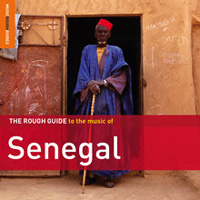
ROUGH GUIDE TO SENEGAL (RGNET 1284)
One of the problems with trying to do a mainstream compilation is that the world is no longer full of curious people who know nothing about particular musics. With the internet jammed with blogs full of esoteric music, if you are remotely interested in some aspect of music you can find whatever you want on the net, usually for free. Though the US government has moved to shut down filesharing servers they are less interested in going after copyright violators who post music whose copyright is not owned by majors like Warner or Sony. But pursuing the blogosphere can get tiresome: some bloggers are so determined to show you the extent of their hipness they post really obscure stuff which may not be worth hearing. However, sooner or later you may discover what you are after if you persevere. Even with my own eclectic tastes in music I have been amazed to find stuff I did not know existed. Bloggers, like Stefan at worldservice, demonstrate far more knowledge and greater depth of collecting in some areas of African music than me, so I follow his site regularly. Then there are specialist sites that pop up like the new angola 45 site that are quite remarkable.
So this dilemma of trying to appeal to a jaded or at least already somewhat knowing audience is a problem with Rough Guides (and other compilation labels like Nascente or Putumayo): the totally uninformed market is shrinking. The revised Rough Guide to Senegal (due out Jan 28, 2013) starts off with Cheikh Lo and Orchestra Baobab, but if you are at all interested in African music you have all their albums. Yes there's good stuff on here, like Etoile de Dakar and Fallou Dieng, but you also have them on Stern's, right? Sister Fa is bad rap; Nuru Kane is the kind of pan-African jam that doesn't engage you, and so on. Increasingly with Rough Guides you may get the album for the bonus disc, which often was previously issued on the Riverboat subsidiary as part of their "Introducing..." series. The Rough Guide to African Guitar Legends (which was rubbish) had a great Syran Mbenza disc as the bonus (It had appeared as Immortal Franco: Africa's Unrivalled Guitar Legend.) The Daby Baldy bonus disc is the reason to get the new Rough Guide to Senegal, unless you got in in 2005 as Introducing Daby Balde. I gave it a rave review back then, as you can read on my Senegal Essentials page. The main album is full of the usual suspects with one or two unknowns who are unknown for good reason.
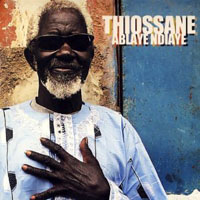
ABLAYE NDIAYE THIOSSANE
THIOSSANE (Discograph/Syllart 3247952)
A native of Thies in Senegal, Ablaye Thiossane has waited over 70 years to make his debut. In the early fifties his father used to play Duke Ellington and Tino Rossi 78s which inspired him to take up music, and the then-prevalent Afro-Cuban style. In 1966 he was recognized at the Festival of Negro Art by President Leopold Senghor for his song "Talene lampe yi," which became a hit. He has re-recorded it here, along with a bunch of great material that has that warm feeling of dry West African desert winds. Guests include Papa Noel & Cheikh Tidiane Tall on lead acoustic guitar, Orchestra Baobab's Thierno Kouyaté on alto sax, and their Mountaga Kouyate on percussion. There's also accordeon, electric bass, sabar and other drums. Kouyaté's alternately strong and dreamy sax has been heard on Lat-Dior (when Thierno played with Ouza et ses Ouzettes in 1982), & on Bambay Gueej, my favourite album by Cheikh Lo from 1999. He's even played with Etoile de Dakar. If it seems like old home week: Medoune Diallo, the vocalist from Baobab, also shows up to do a guest shot. The Cuban styles are not completely subsumed in the African idiom: "Thiere Lamboul" has a familiar son riff from Trio Matamoros that has been through the wash with rock, cumbia, soukous, etc, and still not faded. "Bouki Ndiour" is the most laid-back track and sounds like they were really jamming and having fun. Fans of Baobab, Super Cayor and other classic Senegalese bands will love this.
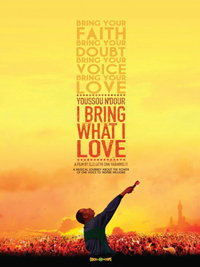
YOUSSOU NDOUR: I BRING WHAT I LOVE
(Oscilloscope Features; Elizabeth Vasarhelyi, director)
A fine full-length documentary on Youssou Ndour that gives a good retrospective of his career and also centres around his recent Egypt album which was a breakthrough for him in many ways. Youssou has one of the greatest voices in Africa. I remember him on his first US tour, being taken by his humility and especially his energy and the wild dancing that went on during his show. But over the years he changed and we saw his shows become more rock spectacles and less the night in the small club we longed for. So we glommed onto Baaba Maal and others 'til they too caught a whiff of the International jetstream and tried to get that important gig with Bono, Bob Geldoff or Peter Gabriel. While to Youssou getting a Grammy Award and having a top-ten hit with "Seven Seconds" were a big deal, those were indications of him losing his authenticity to many of his fans. Though it struck out in a completely new direction, Egypt was a turning point and I thought the best thing he had done in a decade. But surprisingly the Egypt album was not a hit at home. The Senegalese unilaterally rejected it, some even calling it blasphemous: A pop singer was not supposed to sing religious music. There was even a rumour he had half-naked dancing girls at the tomb of the prophet Mohammadou Bamba, making a video. Police had to intervene to prevent a riot. Youssou explained how Umm Kulthum inspired him, he used to listen to her songs with his father, and she had the ability to unite all Arab nations. But the Senegalese were usually left out of the equation, despite being a Muslim and predominantly Sufi nation. And Youssou's trepidation is apparent when he meets the Cairo orchestra because, though he is fluent in Wolof, French and English, his Arabic is pretty shaky. Nevertheless the Egypt cycle debuted at the Sacred Music Festival in Fez, and despite Youssou's nervousness that he was just the singer, not the arranger or conductor, and had to follow directions like the rest of the large group, it was an artistic triumph. The background music, editing and filming of this documentary are superb. A simple moment, like Youssou washing his feet backstage at Carnegie Hall, surrounded by framed signed portraits of Leopold Stokowski, etc, becomes profound. In addition the early footage of Youssou with Super Etoile in their heyday is wonderful. For those of us who never got the opportunity to see the big Cairo string ensemble backing Youssou on his "Egypt" tour, this film is the next best thing.
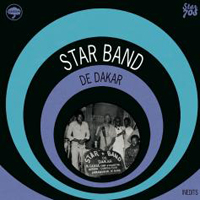
STAR BAND DE DAKAR
INEDITS 70s (Cantos)
While better known that Super Diamono, Star Band's work is in worse state of preservation. A lot of their early cassettes are shrill and sound like the playback heads had sandpaper on them. Nevertheless Cantos has entered the field with a retrospective album of rare material. Quite recently Sylla put out a 2-CD set of Starband Number One, the splinter group led by Pape Seck, that broke off from Star Band. I compared the tracklist on Amazon with the published Starband No 1 CDs (two on Dakar Sound, DKS6 & 19, and one on Popular African Music, PAM307). Apart from one track, "Nongui Nongui" that appeared on DKS5 "Double concentrée," only 5 of the 26 tracks had not been collected before (unless, as is often the case, the names have been changed). For this collection, drawn from the period 1978-9, Cantos shows the birth of the mbalax sound with the young Youssou Ndour, as well as Omar Pene, Ismael Lô, Laba Sosseh and Pape Fall. Surprisingly very little of this material has been heard before outside of the original cassettes. "Thieli" & "Mane kouma khole thi yao" (one of my all-time favourites) appeared on STCD3004, volume 1 of Stern's 4-disc retrospective of Youssou. "N'deye n'dongo" and "Litie Litie" have popped up on more obscure collections, but here is a straight shot of the early Star Band doing what they do best. Track two is a romping cover of "El paso de encarnación," first performed by Antonio Machin and popularized by Larry Harlow. There are still some of the Baobab-like ballads with a latin tinge, trumpets and so forth, but the sabar comes to the fore and the timbales recede as the set goes on.